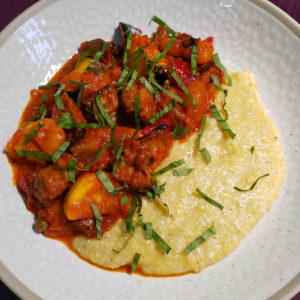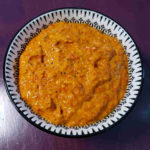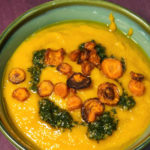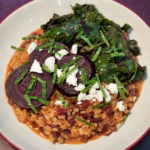According to Wikipedia, the word “ratatouille” is derived from touiller, which means “to stir up,” and generally referred to a course stew. Recipes for modern ratatouille didn’t appear in print until the 1900s. Ratatouille is often considered a French peasant dish. Certainly, the ingredients are humble: tomatoes, summer squash, eggplant and sweet peppers. But, adding the savory complexity gained from aromatic onions and garlic, along with a mix of fresh herbs, ratatouille can be the most delicious mess of vegetables you’ve ever had on a plate.
Some versions of ratatouille call for all the ingredients to simply be stewed together. But that’s not optimal for any of the ingredients. My alternative is to use the stovetop to make a top-notch tomato sauce. While the tomato sauce is simmering away, the oven is used to prepare the eggplant, sweet peppers and summer squash each on their own individual trays to their own individual perfections. When it’s time to serve, my favorite way is alongside a creamy, cheesy polenta.
Preparing the Tomatoes
Ratatouille needs a great tomato sauce. The tomato sauce is the bridge between the flavors of all the other vegetables. If you have a favorite tomato sauce recipe, go with that. Here I use a rather traditional method of starting with aromatics (onions and garlic), then adding the tomatoes and let them simmer away. Towards the end of the cooking process, fresh herbs are added. And, to finish things off, I use an immersion blender to smooth everything together.
Preparing the Eggplant
As I describe on our eggplant hub, a secret for both roasted and grilled eggplant is to prepare the eggplant with a bit of brine and olive oil. First, chop the eggplant into appropriate pieces. Then toss the eggplant with the brine and oil and let it sit in a bowl for 15 minutes or more. Give the bowl an occasional stir. The surface of the eggplant will visually change as the brine draws moisture out of the flesh and the oil is absorbed. Spread the eggplant on a baking tray, making sure a cut side is down for each piece (the majority of the color will be developed where the cut side is in contact with the tray). Roast the prepared eggplant on a bottom/middle shelf at 400°F for 30 minutes. The surfaces of the eggplant will caramelize and firm up, while the interior cooks up to a wonderfully custard like texture.
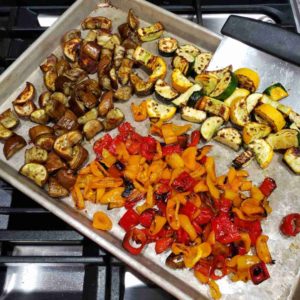
Preparing the Peppers
Roasting peppers concentrates their sweetness and gives them a fuller flavor. Then tossing them under the broiler for a couple minutes to add some caramelization and char builds another layer of flavors. Start the peppers on a bottom/middle shelf and let them roast at 400°F for about 10 minutes. Turn on the broiler and give it a couple minutes to heat up. It’s fine to leave the peppers and eggplant roasting on the lower shelves as the broiler heats up. Move the pepper tray to the shelf just below the broiler and give them a couple minutes to color up. Watch them to prevent burning!
Preparing the Summer Squash
As I describe on our summer squash hub, water is the challenge when preparing summer squash. When raw, summer squash has a pleasant firm texture and a subtle flavor. Once you begin to cook it, however, water is released internally. If the cooking method doesn’t deal with removing the internal water, the squash will be soggy. That is, it will be soft and it will taste watery. The method I use here is to leave the squash in its firm state by not overcooking it. First, cut the squash into appropriate size pieces, then toss them with some salt. Let them sit for 15 minutes. The salt will draw water out of the squash. Drain the excess water and then put the squash in a clean dishtowel and dry the pieces as best you can. Next toss the squash with olive oil. Spread the pieces on a baking tray and put them on the top shelf, under the broiler, just long enough to get caramelization and char on their top side.
Secret Ingredients
There’s no doubt that the combination of vegetables discussed thus far make a wonderful flavor combination. But, there is room to take things up one more notch. I like to add little flavor bombs into the mix. A couple of tablespoons of drained capers is really nice. Chopping up several of your favorite olives is another option. Whether you use either is up to you, but you should definitely garnish with flavorful fresh herbs. Basil is my favorite. Parsley or rosemary are my fallbacks.
Bringing it All Together
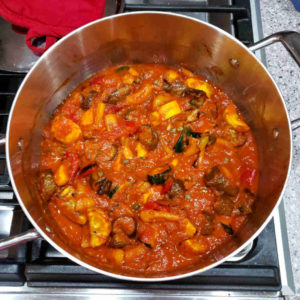
Once the sauce is prepared, and the vegetables are roasted, it’s as simple as adding the vegetables to the sauce pot, simmering just long enough to bring everything to the same temperature and to allow the tomato sauce to start penetrating the vegetables. Since all the vegetables are already cooked optimally, you don’t want to simmer for long or you risk overcooking things. When it’s time to plate, having a starch to pair is a good thing. My favorite pairing is a cheesy polenta which is made on the stovetop in parallel with this dish. You can keep things vegan by skipping the cheese in the polenta. Another great option for the starch is a loaf of crusty bread that was warmed in the oven alongside the roasting vegetables. And, if you or those you are feeding crave a little bit of meat, merguez sausage is a great companion to this meal.
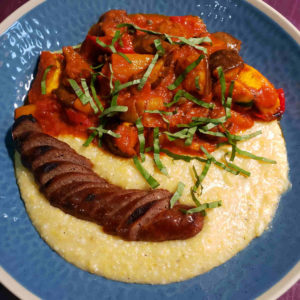

Roasted Vegetable Ratatouille
Equipment
- sauce pot
- 3 baking trays
Ingredients
For the Tomato Sauce
- 2 lbs tomatoes
- 1 medium onion (about 6 oz by weight) diced
- 3 garlic cloves minced
- 1 tbsp fresh oregano chopped
- 1 sprig of fresh thyme
For the Roasted Vegetables
- 1 lb sweet peppers
- 1 lb summer squash
- 1 lb eggplant
For the Dish
- olive oil
- salt and pepper
- 2 tbsp drained capers (optional)
- Several leaves of fresh basil for a generous garnish
Instructions
Prepare for the recipe
- Arrange three shelves in the oven with one shelf immediately below the broiler and the other two in the lower half of the oven. Preheat the oven to 400°F
- Note, much of this recipe can be done in parallel. For example, while the eggplant is brining and the summer squash is resting with salt, you can start the tomato sauce and prepare the peppers. Just keep the big picture in mind as you go through the process. You are making a tomato sauce, and simultaneously preparing and oven cooking the other three vegetables.
- Prepare the eggplant. Chop the eggplant into ¾ to 1 inch chunks and place in a bowl. Combine 1 ounce of water, 1 ounce of olive oil and 1 teaspoon of salt in a small bowl or jar. Whisk or shake the contents until the salt has dissolved in the water and the water and oil have temporarily combined. Pour this over the eggplant chunks. Toss the eggplant to completely coat in the brine and oil mixture. Set aside for at least 15 minutes. Stir occasionally to redistribute any liquids settling in the bottom of the bowl.
- Prepare the summer squash. Cut the summer squash into pieces that are ¾ to 1 inch, and place in a bowl. Sprinkle 1 teaspoon of salt over the squash and toss to distribute the sauce. Set aside for at least 15 minutes. The salt will draw water out of the summer squash, allowing it to be more ready for caramelization under the broiler.
Prepare the Tomato Sauce
- Sauté the diced onions in olive oil with 1/2 teaspoon of salt over medium-high heat. Use enough olive oil to make the onions glisten without any oil pooling in the bottom of the pan.
- While the onions are cooking, core the tomatoes and cut into chunks that are ¾ to 1 inch in size.
- After the onions have softened, turned translucent and just beginning to color, add the minced garlic. Continue to sauté for another minute or two.
- Add the tomatoes and allow to simmer. The tomatoes will soften, release their juices and slowly break down. Stir occasionally to judge how the cooking is coming along. Allow them to simmer at least 15 minutes before adding any other ingredients. More time is generally better.
- Add the oregano and thyme and simmer another 10 minutes.
- Use an immersion blender to puree the tomatoes, aromatics and herbs. Taste for seasoning. Add salt and pepper to taste.
Roast the Eggplant
- The eggplant takes the longest to cook, about 30 minutes, so you want to get it in first. Spread the eggplant evenly over a baking sheet. Make sure each piece of eggplant has a cut side in full contact with the sheet, where it will generate some caramelization.
- Continue to work on other aspects of this recipe while the eggplant roasts.
- After 30 minutes, remove the tray with the eggplant and check for softness. If you push with your fingertip, you should find the eggplant to be nice and soft. If some of the pieces still seem to be firm, put the tray back in the oven for another 5 minutes.
Roast the Peppers
- The peppers will need 15-20 minutes of roasting, and then a few minutes under the broiler to finish. They go in second.
- Core and deseed the peppers and chop them into pieces that are ¾ to 1 inch in size. Toss them with a tablespoon of olive oil and ½ teaspoon of salt. Spread evenly on a baking tray and move to a lower shelf in the oven along with the eggplant.
Broil the Summer Squash
- You should find that water has pooled in the bottom of the bowl where the squash was sitting with the salt. Drain that liquid. Place the squash over a clean dish towel and towel dry the pieces. This water would prevent caramelization under the broiler. That's why we are going through this trouble.
- Change the oven from 400°F to a high broil. It's OK to leave the eggplant and peppers roasting on the lower shelf while the broiler heats up.
- Toss the squash with about a tablespoon of olive oil. Spread them evenly over a baking sheet. Transfer the baking sheet to the shelf directly under the broiler.
- Broil for a couple of minutes, watching the progress. You want to see some caramelization and a bit of char on the squash. But you don't want it to burn, and you don't want it to really cook. You want it to maintain it's firm texture while gaining flavor from the broiling.
- After the squash is removed from the broiler, move the peppers to the shelf under the broiler. This should also just be a couple of minutes. Get some color on the squash, but don't burn them.
Finish Things Up
- Once the vegetables are all finished in the oven, combine them with the tomato sauce.
- Stir and simmer everything together for just a couple minutes. You don't want to cook the vegetables any further, but you do want everything to come to an even temperature and for the sauce to begin penetrating the vegetables.
- Optionally add two tablespoons of drained capers, stirring them into the mix. Another alternative would be chopped olives as little flavor bombs mixed in with the vegetables.
- Plate with polenta or warm crusty bread. Add a generous amount of julienned basil as a flavorful garnish.

